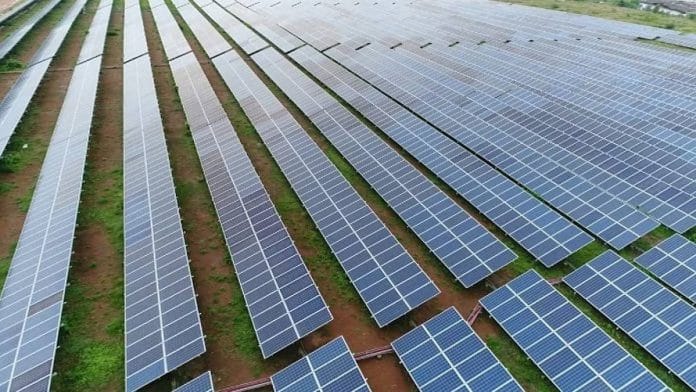New Delhi: India is now the world’s third-largest solar energy producer, behind China and the US, and ahead of Japan, shows the Global Electricity Review 2024 by global energy think-tank Ember.
India added 18+ terawatt hours (TWh) of solar energy in 2023, which formed 5.8 percent of the total electricity mix in the country, according to the report.
Ember has produced the fifth edition of its annual report, published Wednesday, on the state of renewable energy generation globally. It looks at 80 countries and assesses their energy growth, since they make up 92 percent of global electricity demand.
The report states that for the first time ever, the world has achieved 30 percent of renewable energy in its total energy mix as of 2023, and most of this addition comes from solar and wind energy sources.
Since the goal of the COP28 climate summit (held in Dubai last year) is to triple renewable energy capacity by 2030, renewable energy is expected to make up 60 percent of global energy consumption by then.
“The renewables future has arrived,” Ember’s global insights director Dave Jones said in a communication. “Solar in particular is accelerating faster than anyone thought possible.”
Until 2021, wind energy growth had always been higher than solar energy’s, but in 2022 and 2023, solar has surpassed wind as the fastest-growing renewable energy source.
Solar’s rise in most countries has been due to supportive policies, rapid drop in prices and availability of solar panel modules and a drop in battery storage costs, states the report. To put it in context, in 2022, global solar capacity addition was 268 GW, according to BloombergNEF, while it was 444 GW in 2023. This is a big rise, and according to forecasts from the International Energy Agency and Ember, this is expected to grow even more.
Solar energy’s growth rate in the last decade (2012-2022) has been 23 percent, which is positive news. Ember’s report forecasts that to achieve the tripling of renewable energy capacity globally by 2030, solar energy needs to maintain just a 9 percent growth rate in the next decade.
The Global Electricity Review 2024 also highlighted that while solar and wind energy generation saw 23 percent and 10 percent growth, respectively, in 2023. Fossil fuel generation logged 0.8 percent growth in the same period.
Also Read: India’s solar waste to fill 720 Olympic-sized pools by 2030 — CEEW study calls for robust recycling
What about fossil fuels?
According to the analysts at Ember, fossil fuel energy generation is expected to fall slightly this year due to solar and wind energy growth.
Ember’s report further states that half of the countries in the world have already crossed their “peak fossil fuel electricity generation” point and are five years past it.
Most major economies are “steadily declining” in coal generation. The US saw a 19 percent fall, Japan saw a 6.3 percent decline while the European Union saw a 25 percent slump in coal generation, but the reasons were different, the report notes.
In the US, it was mainly the switch to natural gas from coal, while in the EU it was wind and solar energy that contributed to this reduction.
India, however, is still one of the top four coal generating countries, along with China, Vietnam and Mexico. China is expected to see a 3 percent fall in coal generation in 2024, but there are no such forecasts for India currently.
China and India are also among the nations where global electricity demand was the highest, and Ember forecasts that this will continue to grow because of strong GDP growth, rise in electric cars and heat pumps, and also the industrial push in these countries right now.
Further, the rise in fossil fuel generation in China and India in 2023 was due to recurring droughts that reduced their capacity to generate hydro-energy. In India, hydro-generation dropped by 15 percent while China saw a 4.5 percent drop, according to the report.
Hydropower actually fell to a five-year low in 2023 because of the droughts, but remains the largest clean energy source in the world right now. The reason the power sector emissions did not see a reduction globally is because of the recorded loss of hydropower, however, solar energy is slowly expected to make up this loss.
Another key reason for rising electricity demand across the world is the increasing use of air conditioners, notes the Ember report.
India’s solar energy generation and storage
India’s solar energy generation is in line with the global trajectory, since it saw the world’s fourth-largest increase in solar generation in 2023 by adding 18+ TWh of solar energy. It is right behind China, US and Brazil, which added 156 TWh, 33 TWh and 22 TWh, respectively, last year.
This rise in solar energy has occurred steadily, with India’s current solar capacity being 17 times higher than its 2015 capacity. In addition to power generation, India has also taken strides in adding to its battery storage capacity.
On Wednesday, the Delhi Electricity Regulatory Commission (DERC) announced that it has granted regulatory approval to India’s first commercial utility-level Battery Energy Storage System (BESS) at Kilokari substation in Delhi. Since it is a utility-level unit, the BESS has a 20 MW/40 MW per hour capacity, which is 100 times what a usual residential BESS would have.
With this new energy storage system, partially funded by the Global Energy Alliance for People and Planet (GEAPP), the government plans to provide 24×7 reliable power supply to 12,000 low-income households, according to a statement by GEAPP.
Renewable energy storage systems are one of the biggest challenges for energy transition in the upcoming decades, according to the Ember report. Projects such as the GEAPP and DERC’s commercial storage system in Kilokari will be crucial in the future if India is to meet its COP28 renewable energy targets.
(Edited by Nida Fatima Siddiqui)
Also read: India, Germany look to promote private investment in renewable energy for achieving 2030 target






